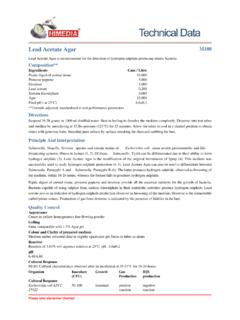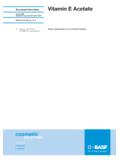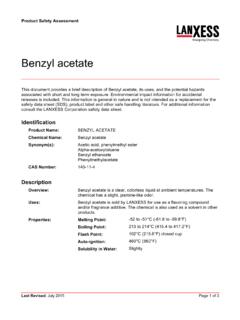Transcription of Determining the Gel Content of Ethylene Vinyl …
1 Specialized Technology Resources, Inc. Determining the Gel Content of Ethylene Vinyl acetate Purpose The gel Content (insoluble fraction) produced in Ethylene Vinyl acetate (EVA) plastics by cross-linking can be determined by extracting with toluene. This procedure describes the method used to determine the gel Content of Ethylene Vinyl acetate . Safety Precautions Toluene is a flammable substance. Do not use near open flames. Use this chemical in a fume hood. Wear safety glasses. Wear chemical resistant gloves.
2 Read the Material Safety Data Sheet for toluene before using. Principle ethod is to determine the gel Content of the EVA. The purpose of the mGel Content provides a means of both controlling the process and rating finished product quality. Glass jars equipped with foil-lined caps s ) paper) pparatus "Low Form" weighing bottles with cover Filter Paper (Whatman No. 54 size cm Glass funnels (large enough to hold the filter Glass beakers (for toluene waste filtrate) Vented calibrated oven Analytical balance Desiccator A Tongs Reagent grade toluene eagents l," 2,6 di-Tert-butyl-4-methylphenol) R BHT antioxidant ("Iono Continued on next page Specialized Technology Resources, Inc.
3 Determining the Gel Content of Ethylene Vinyl acetate Hazardous Material Toluene is a flammable chemical and should be handled and disposed of accordingly. Be sure to wear safety glasses, gloves, and a respirator when working with this chemical. Step Action 1 Cut approximately two inches from all four sides of the cured 12 inch x 12 inch sample. 2 Discard this two inch border. 3 Cut a gram specimen from the middle section of the cured sheet.
4 4 Weigh the specimen to the nearest g. Note: This is your W1 weight. Prepare EVA Sample 5 Place the weighed specimen in a glass sample jar. Step Action 1 Fill a glass container with 100 ml reagent grade toluene per sample. Note: For duplicate specimens you will need 200 ml total. 2 Add enough antioxidant to obtain a concentration of percent. Example: 100 ml of toluene will require g of BHT. (density of toluene is g/ml).
5 3 Add toluene to sample jars. 4 Swirl the contents two times to distribute the BHT. Note: Two swirls performed at once. 5 Cap the jars Combine Sample with Reagents 6 Place the sample jar immediately in the oven preheated to 60 C. Note: Maintain the sample jar at 60 C for a minimum 20 to 24 hours. Continued on next page Specialized Technology Resources, Inc. Determining the Gel Content of Ethylene Vinyl acetate Step Action 1 Preheat an oven at 105 C.
6 2 Place the filter paper, weighing bottle, and cover in the oven at 105 C for two hours. Note1: This can be done prior to removing the specimen from the oven at the end of the minimum 20-24 hour period. Note2: Do not handle these materials with your hands, use At the end of the time period immediately cap the weighing bottle and place the bottle and filter paper in a desiccator until cooled to room temperature. 4 Once at room temperature weigh the weighing bottle, cover, and filter paper to the nearest g. Note: This is your W2 weight.
7 Dry Filter, Bottles, Covers 5 Return to the desiccator until ready to use. Step Action 1 After the 20-24 hour period immediately remove the sample jar from the oven and place in a fume hood. 2 Place a glass funnel in the toluene waste beaker. Note: A ring stand may be used to hold funnel. 3 Place the pre-weighed filter paper in each funnel. Note1: Use a small amount of clean reagent grade toluene to secure the filter placement.
8 Note2: This is done by pouring the solvent down the sides of the funnel/filter paper. 4 Pour contents of the sample jar into the funnel/filter paper setup. 5 Rinse the sample jar and filter paper again with clean solvent. Note: A reagent grade toluene filled squeeze bottle is Place the filter paper with residue into a weighing bottle. Extract Soluble Portion 7 Place the weighing bottle and corresponding cover side by side in an oven at 105 C. Continued on next page Specialized Technology Resources, Inc. Determining the Gel Content of Ethylene Vinyl acetate Step Action 1 Allow the sample to dry at least four hours, until a constant weight is achieved.
9 2 At the end of this time period cap the weighing bottle and place in a desiccator until cooled to room temperature. Dry Insoluble Portion 3 Weigh the weighing bottle and its contents to the nearest g. Note: This is your W3 weight. Calculation Where: (W3 - W2) x 100 = % Crosslinked Material W1 W1 = Weight of the original specimen in grams. W2 = Weight of the weighing bottle, cover, and dried filter paper in grams. W3 = Weight of the weighing bottle, cover, dried filter paper, and dried residue. Apparatus Used for Determining Gel Content Analytical Balance Desiccator Sample Jar Weighing Bottle Filter Paper Filter Paper Glass Funnel Weighing Bottle w/sample Filter / Funnel Specialized Technology Resources, Inc.
10




